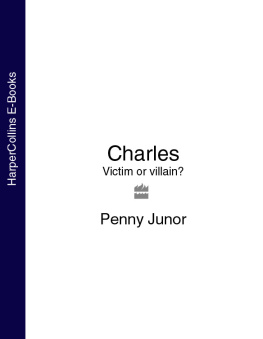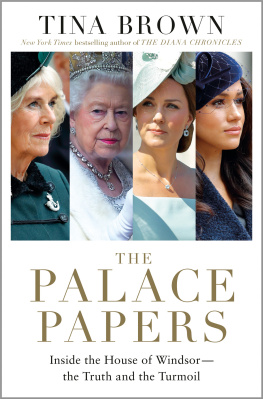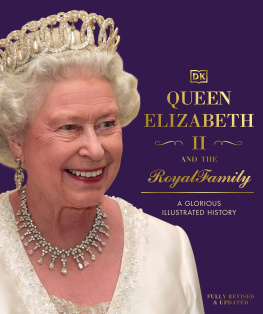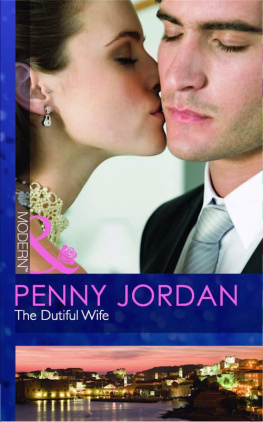PENNY JUNOR
The Firm
The Troubled Life of the House of Windsor
The King, Queen and Princess on the balcony (Rex)
Lady Diana Spencer in see-through skirt (Rex)
The Royal Family on the balcony with Diana and young Princes at Trooping the Colour (Tim Graham)
The Family on the balcony during the Golden Jubilee (Tim Graham)
The Party at the Palace (Tim Graham)
The Prince of Wales shooting with Michael Fawcett (Eddie Boldizsar/Rex)
Paul Burrell carrying a corgi (Tim Graham)
The Queen arriving in Saudi Arabia on Concorde (Tim Graham)
The Queen and Prince Philip in the Gold State Coach (Tim Graham)
Prince Philip in bearskin (Les Wilson/Rex)
Queen Elizabeth the Queen Mother with Irish Guards and wolfhound (Tim Graham)
The Queen at the Windsor Horse Show (Les Wilson/Rex)
The Kiss on the balcony (Tim Graham)
Charles and Diana in Korea (Tim Graham)
The Princess of Wales with children in her arms (Tim Graham)
Princess Anne standing by a cot (Tim Graham)
Diana crouching to talk to hospice patient (Tim Graham)
Diana in surgical mask (Rex)
Prince William with hand to mouth for 18th birthday (Rex)
Queen Elizabeth IIs coronation (Rex)
Queen Mothers funeral (Tim Graham)
Prince William over a hot stove (Rex)
Prince William in school uniform with Union Jack waistcoat (Rex)
Prince Edward with Sir Cliff Richard at Its a Royal Knockout (Rex)
Princes William and Harry playing polo on bicycles (Les Wilson/Rex)
The Queen wrapped up against the weather with a labrador and spaniel (Greaves/Rex)
The Queen with Princess Anne and Zara Philips, all on horseback (Tim Graham)
A tearful Queen leaving the 9/11 memorial service (Tim Graham)
The Prince of Wales and Camilla Parker Bowles on the evening their engagement was announced (Rex)
Prince Charles with Lady Diana Spencer after their engagement (Tim Graham)
Prince Charles and Prince William on the 50th anniversary of VJ Day (Tim Graham)
Prince Charles and Prince William with cows on the Home Farm (Les Wilson/Rex)
Prince Harry being restrained outside a London nightclub (David Abiaw/Rex)
The Princess of Wales during the Panorama interview (Rex)
The Queen at the Derby both glum and jubilant (Les Wilson/Rex)
The Queen and Duke of Edinburgh meeting flag-waving children (Tim Graham)
The Queen arriving at Bristol on the Royal Train (Tim Graham)
Princes William and Harry sharing a joke on the balcony at Buckingham Palace (Les Wilson/Rex)
Once upon a time kings and queens ruled the land. There was nothing mysterious about it; some of them invaded to take up the throne, others inherited via one route or another, but once installed they governed, they were the executive, they were all-powerful, they had their own armies and they chopped off the heads of anyone who thwarted them. People may not have liked their monarch, they may have grumbled about taxes or the extravagance of the court, or been tired of endless skirmishes with France, but no one was ever in any doubt about what their monarch was for.
Twelve hundred years later, after many changes (and a brief period in the seventeenth century when there was no monarch at all), we have a Queen who has no executive power, who acts entirely on the advice of ministers, who reads speeches that others have written, and who relies upon government for her keep. Four years after she came to the throne, a poll suggested that 34 per cent of the population believed that Elizabeth II had been chosen by God. Today youd be hard pushed to find anyone who believed that God was involved in the process its becoming enough of a challenge to find people who believe in God, full stop. Under these circumstances, in an age when our social order is based upon merit rather than inheritance, it is not surprising that we should ask what monarchy is for. Most children havent a clue, wouldnt recognize members of the Royal Family and probably couldnt care less. Their local football team or the latest contestants in Im A CelebrityGet Me Out Of Here! are more relevant to their lives. There is indifference among the younger generation that must make the future of the monarchy highly questionable.
Republicanism is nothing new. There has always been a minority chipping away at the credibility of the monarchy, and although they seem to be increasingly vocal, they are still very much in the minority. But today even monarchists are beginning to question whether the institution, steeped as it is in history and tradition, can survive in the current climate of indifference and disrespect towards institutions and authority. And perhaps more importantly, as the newest member, the controversial figure of Camilla Parker Bowles is finally welcomed into the fold, as HRH the Duchess of Cornwall, whether the Royal Family, as individuals, can survive the ever more intrusive and destructive demands of the modern media.
The world has changed during the course of the present Queens reign, arguably more radically in the time span than at any period in history. Television was in its infancy when the Queen came to the throne in 1952. Many families, my own included, bought their first television set to watch the coronation tiny little black and white sets that had to warm up before you saw a picture which then shrunk to a white dot when you turned them off. Fifty-two years later even the most modest mobile home has a colour television with a satellite dish on the roof, and in most households people would sell their granny before parting with the TV. It sits in pride of place, chattering away every waking hour, and defines our view of the world. News rolls seamlessly into drama, fact into fiction and all that is remembered is the sound bite.
And what television has created is the cult of the celebrity. People whose faces we recognize from the screen are the new idols, no matter whether they have talent, wit or wisdom. If their face has been on the box often enough for it to become familiar, they have instant status and national fame. And the public is greedy to know everything about its celebrities which is where newspapers come into their own.
Newspapers have also changed since the fifties. When the Queen first came to the throne the newspapers, reflecting the age, were deferential towards the monarch. Proprietors could be relied upon to keep any whiff of royal scandal out of the papers. There were two court correspondents employed by the Press Association who went to Buckingham Palace for briefings dressed in morning dress and top hat and meekly lapped up official notices and announcements.
Todays equivalent is a tabloid rat pack charged by their editors with finding exclusives gossip, scandal and as much personal detail as possible, and, in some cases, by whatever means possible. And the Royal Family is considered to be fair game, as the Countess of Wessex discovered to her cost when a reporter posing as a Middle Eastern sheik tried to employ her PR company. Actors, footballers, pop stars, politicians many have suffered similar stings or found themselves unwillingly making headline news. And for a family that is dependent upon an army of staff to run their lives, it was only a matter of time before some of them became disgruntled or found irresistible the opportunity to make money by speaking to the press.
This is the environment in which todays monarchy has to operate. It needs the oxygen of publicity no less than actors, entertainers and politicians, or anyone else with something to sell. The Queen understands this only too well, from history as well as her own experience. Never has the monarchy been so unpopular in modern times as when Queen Victoria vanished from sight after Prince Alberts death in 1861. In her grief, she hid herself away at Balmoral and, although she carried on the affairs of state perfectly well, she did not make a public appearance in London for three years. The people were furious and when they did finally catch sight of her they pelted her carriage with stones. It was apparently not enough that she saw to her constitutional duties. The present Queen stayed away from London after the death of the Princess of Wales she was also at Balmoral and the public was again furious. They wanted to see their Queen. The newspaper headlines during the week before the funeral were the most critical of her reign and it was not until she returned to London and spoke to the nation on television, both as a grandmother and as Head of State, that the crisis, possibly the most serious of her reign, was averted.









